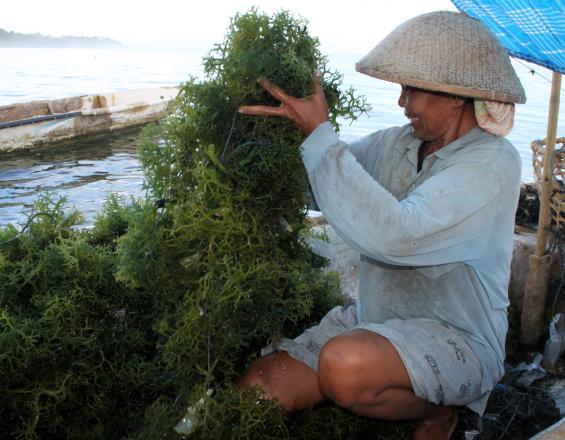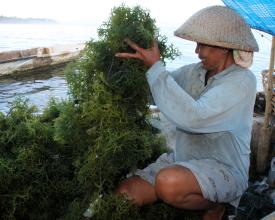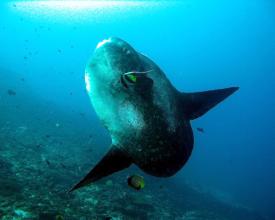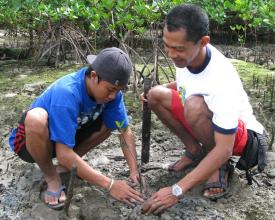
Marine protected area learning site for the Coral Triangle

The high ecological importance of the three islands of Nusa Penida, Bali, Indonesia located in the heart of the Coral Triangle Center is used for developing a MPA learning site. It addresses the lack of formalization of natural resource management and inadequate protection of marine biodiversity with main institutional strategies to foster platforms for on-the-ground learning and sharing of knowledge and skills about tropical marine conservation.
Contexte
Challenges addressed
unlicensed fishing, sewage and pollution, coral mining and climate change effects Nusa Penida has 45,000 inhabitants that depend on marine resources, including fish and seaweed. About 200,000 tourists per year visit the islands. The solution addresses unlicensed fishing, sewage and pollution, coral mining and climate change effects including rise of seawater temperature, seawater level rise, and shift of fishing season that threaten biodiversity, ecosystem and livelihood.
Emplacement
Traiter
Summary of the process
All six building blocks are part of a bottom-up step-by-step approach to achieve the solution. Baseline data collection (building block 1) is the required input for a successful consultative development of zoning the MPA and its management plan with all stakeholders (Building block 2). As a result, the collaborative management process can start that commits and brings together all stakeholders concerned (Building block 4). Options for sustainable financing mechanism (Building block 3) and ecological restoration (Building block 5) are laid out during the consultative development of zoning and management plan (Building block 2) and furthered through the collaborative management of all stakeholders (Building block 4). The process and the success of the collaborative management of the MPA, the use of its ecosystem services and marine ecotourism to generate funds and revenues for the community are shared to support other sites (Building block 6). The establishment of a marine protected area learning site for the Coral Triangle is made possible through continuous governmental, private sector and NGO (CTC) support from the beginning.
Building Blocks
Baseline data collection
Enabling factors
Lesson learned
Consultative development: zoning and management plan
Enabling factors
Lesson learned
Sustainable financing mechanism
The Coral Triangle Center developed an entrance fee system formalized by District Regulation based on a ‘willingness to pay’ survey. The survey indicated that tourists visiting Nusa Penida would pay between USD5 – USD10 per entry. However, the District Government only approved to collect USD1 per visit to avoid decreasing numbers of tourists. In the first year, the collected fee sums up to USD140.000. The 20-year business plan for the MPA, however, indicates the need USD600.000 per year (minimum scenario) and USD800.000 per year (maximum scenario). Thus, currently the entrance fee is covering about 25% of the cost of the MPA management (minimum scenario). The District Government will increase the free gradually to USD5 in 10 years. Assuming 200.000 visitors per year, the entrance fee will reach USD1 million per year, even higher than the maximum scenario costs. Another source of income to cover 20% of the management cost comes from Government budget, souvenirs and merchandise, education trips and collaboration with NGOs and other donors. In addition to rising management costs, the current challenge includes the transfer of authority and tasks such as collecting the entrance fees from the District Government to the Bali Provincial Government due to changed national law.
Enabling factors
- An important tourism industry or potential for tourism
- Pre-existing community benefits from marine eco-tourism prior to establishment of MPA
- Cooperation from private enterprises and marine and coastal tour operators
Lesson learned
- Need accountable and transparent system on entrance fee collection and clear spending system to directly support the services and management of the MPA. This is to ensure credibility of the MPA management as well as trust of tourists who pay the fee.
- Adaptive management needed to adjust to changing or unpredictable situations such as new law and authority transfer
Collaborative management of all stakeholders
Enabling factors
Lesson learned
Ecological restoration
Enabling factors
Lesson learned
Sharing experiences to support other sites
Enabling factors
Lesson learned
Impacts
Coral reef condition and fish populations remain stable based on annual reef health monitoring surveys.
Charismatic and flagship species such as Mola mola and Manta ray are fully protected, and dive tourism from Bali to Nusa Penida is sustainable.
Marine eco-tourism is successfully developed, including mangrove tours, with mangroves being one of the conservation targets of the MPA. Indeed, the MPA has prompted the green image of Nusa Penida’s marine tourism. In 2016, 256.000 visited Nusa Penida MPA. In the same year, the site won for the second time a National AWARD, as one of the MPAs in Indonesia with the highest management effectiveness levels. Nusa Penida MPA progressed towards the blue (75%) management effectiveness level based on the National Evaluation tool (E-KKP3K) by Ministry of Marine Affairs and Fisheries. This is the 2nd highest out of 5 levels.
Data suggests that fishing in the MPA for Nusa Penida and external fishermen is sustainable and fish stocks are maintained.
Beneficiaries
local fishermen, fisheries industry, seaweed farmers, marine tour operators, and tourists
Story
When people on Nusa Penida started seaweed farming in 1984, they would uproot mangroves to create their farms. The cutting of mangrove trees was more or less part of a daily routine. Ten years later residents realized that the ocean came ever closer and didn’t stop at their backyards anymore. The reason seemed obvious: the deforestation of the mangroves. People began to look at the mangroves as not only a source of wood, but as a means of coastal protection. At the same time, more and more tourists visited the island and quite a few seemed to be interested in seeing the mangrove forest. Thus, the locals started to organize mangrove tours. Another ten years further down the road, The Nature Conservancy initiated marine education training on the island, including mangrove replanting and the development of a mangrove seed bank. CTC continued these activities and developed the MPA together with local authorities and communities, allowing the islanders to expand tourism. Local communities were connected with professional tour operators and targeted promotion brought in more visitors on a regular basis. Today, about 35 to 50 people per day sign up for the mangrove tour. This kills two birds with one stone, but fortunately not two fish with one worm: visitors learn about marine biodiversity and the importance of coastal protection while local communities generate additional income and leave destructive practices behind. The outstanding effort of Nusa Penida has been recognized. The island received the national award from the Maritime Affairs and Fisheries Ministry as good example for the most efficient managed MPA. CTC executive director Rili Djohani states “Nusa Penida has become a jewel in Indonesia’s marine protected area system, as one of the most thoroughly planned and zoned MPAs in the Coral Triangle through bottom-up collaborative management that contributed to people’s livelihoods and economies while protecting the world’s biological wealth for future generations.”






